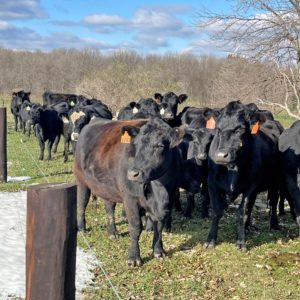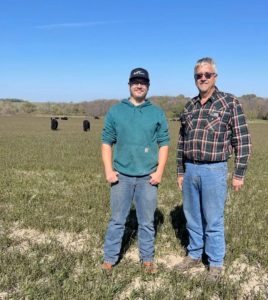Gains With Grains
The decision to add oats has helped Brad Sheely and his sons expand their farm with livestock, harvesting and other enterprises.
In southern Minnesota, just across the Iowa border near Austin, where the drought hit exceptionally hard this year, a once-familiar crop is popping up again amid the fields of corn and beans.
Oats, once a leading crop in Minnesota, saw a steep decline starting in the 1950s as farmers shifted their operations to accommodate market demand for corn and soybeans. Now, oats are returning to a handful of area farms, where they’re helping farmers boost crop diversity, farm resilience and economic opportunity.
For Brad Sheely and his sons Joel and Ben, the chance to grow oats has led to several new enterprises for the whole family – from new markets, to custom harvesting, to the chance to expand livestock on their farm.
From Oats to Cattle
It all started five years ago. While delivering grain with his trucking business, Brad learned of an opportunity to grow conventional oats for Grain Millers in addition to his typical corn and soybean rotation. He started by planting 105 acres of oats, which were destined for Grain Millers’ food-grade markets.
“We did the legume cover crop with it, got the [PFI small-grains] cost-share and at the same time we realized there was a lot of forage out there,” Brad says. At the time, the family had five or six hobby beef cows. Taking advantage of all the extra forage leftover from the oats, Brad’s eldest son, Joel – who runs a baling business – baled the oat straw and the family bought more cows.
“Ben is working to build a [cattle] business and it is all because of the
small-grain and legume cost-share in that first year.”
– Brad Sheely
The flow-on effect continued. Ben, Brad’s youngest son, saw the opportunity to add a cow-calf herd to the operation. He has now grown the herd to 60 head. “Ben is working to build a business and it is all because of the small-grain and legume cost-share in that first year,” Brad says, noting that the cost-share is how he first got connected to Practical Farmers. He describes the cattle enterprise as a logical next step of adding oats and cover crops and seeing the new opportunities they opened up to raise a herd.
Along with adding oats to his rotation, Brad has also taken up custom harvesting as more farmers in his area have started growing small grains. He sees this as one of the benefits of being an early adopter. “I’m the only guy around here with a windrower and a combine to pick up the swath,” Brad says. “So we do quite a bit of custom work with that equipment.”
These new enterprises all stem from the initial decision to add oats to the rotation. But the family’s oat crop has also helped them manage risk – which was especially evident during the 2023 drought. “This year our oats made 125 bushels,” Brad says. “They matured before the worst part of the drought came. We did not get any legume cover crop due to the drought, but with the oats yielding really well, they were good risk management.”
Cattle Insights
Before growing oats, the Sheelys considered cattle a hobby. They have always enjoyed raising cattle so their transition into building a livestock enterprise made sense. This is a key point, Brad says. “You have to enjoy cattle. If you don’t, I wouldn’t consider raising them.” He advises farmers who want to add cattle to start small. “You are there with them every day,” he says, “and they are a commitment.”
For Brad, another important aspect of the cow-calf operation is that it has enabled the younger generation to get started farming. Ben has been able to build equity through his cattle business. And that business has let Joel and Ben support each other in their farming goals. Joel, for example, sold his cows to Ben, which then allowed Joel to buy his first 20 acres of land to start farming.
The new enterprise has meant grappling with some new challenges – fencing being the most difficult. Brad explains that the farm they rent in a long-term contract “has pasture with 100-year-old fences that were all on the ground.” In addition to rebuilding that pasture fence, the Sheelys are working to build new fence on row crop ground they plan to use for grazing cover crops in the future. “We are building a mile of fence a year,” Brad says. “It is a slow process, and the cost and time is a challenge.”
The family has also fenced a 30-acre field where they plan to start grazing cover crops next autumn. “Our goal is to graze more cattle on more acres in the near future,” Brad says. The fencing work has been necessary to get started raising cattle. But it also connects to Ben’s vision for the cow-calf enterprise: He plans to grow the herd to 100 head.
Expanding Oats and Covers

Ben Sheely saw the opportunity to start a cattle enterprise after his family planted oats on their farm.
The Sheelys have also expanded their oat acres – and they plan to add more. After starting with the initial 105 acres of oats, they now have about 400 acres of oats in rotation each year. “We don’t have all the acres on a three-year rotation,” Brad says, “but we are working towards that.” After corn, they plant cereal rye cover crops on some acres and are looking to expand and graze more of those acres. Part of the motive for this expansion has been the new opportunities these crops have opened up for the family. Soil health is another. But Brad also points out how the oats and cover crops are helping them buffer risk and save money.
“Cattle are expensive now and calf prices are high,” Brad says. “If they’re grazing and getting a few pounds of gain a day, it doesn’t take long to figure out the cover crop is worth more money and still does the [soil health] job we want it to do on the land.” The Sheelys are currently working to secure a three-year Environmental Quality Incentives Program contract to help with cover crops on a field they are also working to fence in and graze.
As the Sheelys have made changes to the farm with oats, covers and cattle, Brad says he has felt encouraged by some of the long-distance landowners he rents from. “They are supportive and excited about doing this stuff on their farm.” Neighbors are also starting to take notice of the family’s practices – and this is leading to new land access opportunities. Earlier in 2023, Brad says a landowner in the area, concerned with doing something to help the soil, reached out to him about growing oats.
“They were watching what we are doing and they asked Joel to grow oats on 100 acres,” he says. “To have someone stop and recognize your practices is impressive.”


